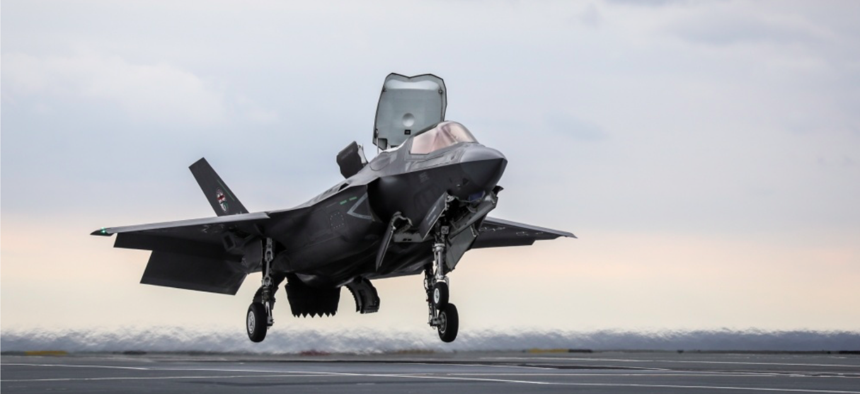
The first ever Shipborne Rolling Vertical Landing (SRVL) has been carried out with an F-35B Lightning II joint strike fighter jet conducting trials onboard the new British aircraft carrier, HMS Queen Elizabeth. Courtesy of Royal Navy
UK Plans a Decade of Weapons Purchases As Auditors Sound Warning Bells
Defense procurement minister reiterates commitment to 10-year, £186 billion purchase plan.
Britain is pushing ahead with big plans for new weapons even as government auditors sound warning bells over the expense.
Stuart Andrew, the defense procurement minister, said the country needs to spend £186 billion ($243.6 billion) to buy new weapons over the coming decade to replace aging equipment and meet Russian threats to Europe.
An unexpected budget bump last week may just be the start. The Defense Ministry received an additional £1 billion ($1.31 billion) in its current budget for immediate weapons needs, including cyber security, anti-submarine warfare and work on new nuclear submarines.
“In an environment where there have been challenges to public spending, for defense to have secured such a large amount really is excellent,” Andrew said Tuesday at the Heritage Foundation in Washington. “Does it solve all of our problems? No it doesn’t … and that’s why we’ve got our comprehensive spending review coming up next year.”
Related: F-35 Lands on New British Carrier for First Time
Related: Russia is Winning the Information War in Iraq and Syria: UK General
Related: At UK Air Show, CEOs and Military Leaders Talk Trump, Tariffs, and Allies
Like the U.S. military, the U.K. is looking to replace its remaining Cold War-era weapons. It is buying four new nuclear ballistic submarines, the Dreadnought class. It’s planning to buy F-35 Joint Strike Fighters, P-8 submarine-hunting patrol planes, and new armored vehicles. It’s also building a second aircraft carrier, HMS Prince of Wales, to complement the new HMS Queen Elizabeth, which is currently conducting trials with F-35s off the eastern U.S. coast.
“We will need to continue to ensure that we make the case for the funding that defense needs,” Andrew said.
The minister’s comments come one day after the National Audit Office bluntly warned that the defense ministry lacks the money for the purchase plan, which would consume about 40 percent of its budget over the next decade.
“The Department’s Equipment Plan remains unaffordable, with forecast costs exceeding budgets by £7.0 billion over the next 10 years,” the agency’s report said. “This variance could increase or decrease depending on different circumstances, with the Department estimating a worst-case scenario of costs increasing by £14.8 billion should all the identified risks materialise.”
Andrew said the planned spending increase “shows our clear commitment that defense is an increasingly important part of what we do.”
The the U.K. is “committed” to buying 138 F-35s (it has ordered 48 so far) even as it begins work on indigenously developing a new warplane called Tempest, the minister said
“We have not yet made a decision on what the next tranche will be [ordered], but the final figure of 138 is a commitment,” Andrew said.
Asked whether the Tempest — slated to replace the country’s Eurofighter Typhoon jets — is a move away from the American-made F-35, Andrew said, “The Tempest in our future combat air strategy does not lessen our commitment to the F-35 program. This is about looking at where we go next. It’s also about making sure in the U.K. we retain the [technical and engineering] skills that we’ve got.”





